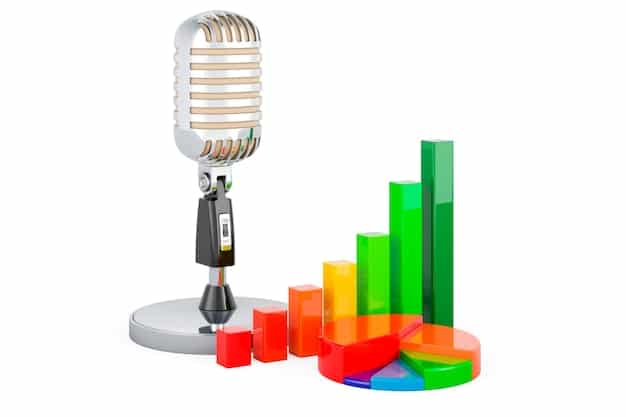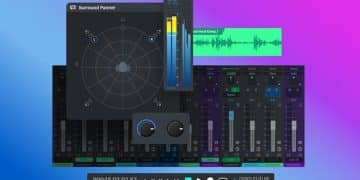Boost Podcast Ad Revenue 15% Q3 2025: Data-Driven Guide

Achieving a 15% increase in podcast ad revenue by Q3 2025 requires a strategic, data-driven approach focusing on audience targeting, dynamic ad insertion, optimized pricing models, and diversified revenue streams, leveraging listener analytics and market trends for US podcasters.
Are you a US podcaster looking to significantly boost your revenue? This comprehensive guide presents data-driven strategies to help you achieve a 15% increase in podcast ad revenue by Q3 2025. Dive into actionable insights designed to transform your monetization efforts and elevate your podcast’s financial performance.
Understanding the Current Podcast Advertising Landscape
The podcast advertising market is experiencing dynamic shifts, driven by evolving listener habits and technological advancements. To effectively increase revenue, US podcasters must first grasp the nuances of this landscape, including prevailing ad formats, industry benchmarks, and the growing demand for highly targeted campaigns. Understanding the competitive environment and the unique challenges and opportunities it presents is crucial for strategic planning.
As we approach Q3 2025, advertisers are increasingly prioritizing measurable results and audience engagement over traditional reach metrics. This shift necessitates a deeper dive into listener demographics and psychographics, allowing for more precise ad targeting. The rise of programmatic advertising and dynamic ad insertion (DAI) further complicates, yet also enhances, the monetization potential for podcasters. These technologies allow for personalized ad experiences, which can lead to higher engagement rates and, consequently, increased ad revenue.
Key Market Trends to Monitor
- Listener Sophistication: Audiences are becoming more discerning, valuing authentic and relevant ad content. Generic ads often lead to listener fatigue and ad skipping.
- Data Privacy Regulations: New and evolving privacy laws (e.g., state-specific regulations) impact data collection and usage, necessitating transparent and compliant ad practices.
- Brand Safety Concerns: Advertisers are more cautious about where their ads appear, requiring podcasters to maintain high-quality content and brand alignment.
The imperative for podcasters is to move beyond simply selling ad slots to understanding the value proposition of their audience. This involves analytical prowess, the ability to articulate listener profiles (LPs), and a keen awareness of what advertisers seek. By focusing on these elements, podcasters can position themselves as attractive partners for brands looking to connect with engaged and specific audiences. The data suggests that advertisers are willing to pay a premium for precision and proven engagement, making audience understanding a cornerstone of revenue growth.
Furthermore, the growth of niche podcasts presents a significant opportunity. While mainstream podcasts may attract large, general audiences, niche shows offer highly engaged and specific listener bases that are incredibly valuable to advertisers targeting particular demographics or interests. This segment offers higher CPMs (Cost Per Mille) due to the reduced wastage and increased relevance of the ad placements. Podcasters should therefore emphasize the unique value of their audience segments, providing detailed analytics that go beyond mere download numbers to demonstrate true engagement.
In summary, successful navigation of the 2025 podcast advertising landscape requires adaptability, a strong commitment to data-driven decision-making, and a deep understanding of both listener behavior and advertiser expectations. Podcasters who can articulate their audience’s value and deliver relevant ad experiences will be best positioned to achieve substantial revenue growth.
Optimizing Audience Engagement Metrics for Higher CPMs
To secure higher CPMs (Cost Per Mille, or cost per thousand listens), podcasters must demonstrate superior audience engagement. This goes beyond raw download numbers, delving into listener retention, average listening time, and interaction rates. Advertisers are increasingly sophisticated, using advanced analytics to evaluate potential ad placements. Therefore, providing compelling data on engagement metrics is paramount for negotiating stronger ad deals and increasing podcast ad revenue.
Understanding your audience’s journey is a critical step. Are listeners tuning in for the entire episode? Are they sharing it on social media? Are they engaging with calls to action from previous advertisers? These are the questions that prospective advertisers will ask, and having robust answers, backed by data, can significantly elevate your podcast’s value proposition. Tools that track listener drop-off points and device usage can provide invaluable insights into content performance and audience habits.
Strategies for Enhanced Engagement
- Interactive Content: Incorporate listener polls, Q&A segments, or community discussions. This fosters a sense of belonging and increases time spent listening.
- Cross-Promotion: Collaborate with other podcasters in your niche to tap into new, engaged audiences. Cross-promotion can bring in listeners who are already pre-disposed to your content style.
- Audience Feedback Loop: Actively solicit and respond to listener feedback. This not only improves content but also makes listeners feel heard and valued, boosting loyalty.
Moreover, consistent quality is a non-negotiable factor in maintaining and growing audience engagement. This includes audio fidelity, compelling storytelling, and a clear, unique voice. A high-quality production ensures listeners stay subscribed and return for new episodes, providing a reliable and growing pool for advertisers. Investing in professional equipment and post-production can yield substantial returns in listener retention.
Another powerful strategy is to leverage social media and email newsletters to build a community around your podcast. Engaged communities often translate into higher listener retention and better ad performance. When listeners feel connected to the host and the content, they are more likely to pay attention to ads and even act on them. This direct connection also provides an organic channel for sharing new episodes and updates, further bolstering engagement metrics.
Ultimately, a holistic approach to audience engagement, combining analytical insights with targeted content strategies and community building, positions a podcast as highly attractive to advertisers. By consistently delivering a valuable experience to listeners, podcasters can confidently justify higher CPMs and accelerate their revenue growth towards the 15% target by Q3 2025.
Implementing Dynamic Ad Insertion and Programmatic Advertising
The evolution of podcast advertising is largely defined by dynamic ad insertion (DAI) and programmatic advertising. These technologies are no longer futuristic concepts; they are essential tools for US podcasters aiming to significantly increase their ad revenue by Q3 2025. DAI allows ads to be inserted into podcast episodes at the point of download or stream, meaning different listeners can hear different ads, tailored to their demographics, geographic location, or listening habits. This personalization dramatically enhances ad relevance and, consequently, click-through rates and conversion rates for advertisers.
Programmatic advertising takes this a step further by automating the buying and selling of ad impressions. Instead of manual negotiations, which can be time-consuming and inefficient, ad slots are bought and sold in real-time auctions. This not only streamlines the process but also allows advertisers to bid for highly specific audience segments, often resulting in higher CPMs for podcasters. The efficiency and targeting capabilities of programmatic platforms offer a clear path to maximizing ad inventory value.
Advantages of Advanced Ad Technologies
- Targeted Campaigns: Deliver relevant ads based on listener data, increasing ad effectiveness and advertiser satisfaction.
- Optimized Inventory: Sell unsold ad slots more efficiently and fill them dynamically, reducing revenue loss from empty inventory.
- Real-time Reporting: Gain immediate insights into ad performance, allowing for rapid adjustments and optimization of campaigns.
Successfully integrating DAI and programmatic advertising requires careful consideration of technology partners. Podcasters should evaluate platforms based on their audience targeting capabilities, ease of integration, and reporting features. Many hosting platforms now offer built-in DAI solutions, or integrate with third-party ad networks that specialize in programmatic buys. Choosing the right partner can unlock significant revenue potential.

Moreover, while these technologies offer automation, human oversight remains vital. Monitoring ad quality, ensuring brand safety, and regularly reviewing performance metrics are crucial. Podcasters should proactively communicate with their ad partners to optimize campaigns, providing feedback on what resonates with their audience and what might need adjustment. This collaborative approach enhances the value for both the podcaster and the advertiser.
Despite the clear benefits, some podcasters express concerns about the loss of control or the perceived impersonality of dynamically inserted ads. However, these concerns can often be mitigated by carefully vetting ad partners and setting clear guidelines for ad content and frequency. The increased revenue potential and efficiency gains offered by DAI and programmatic advertising make them indispensable tools for achieving aggressive revenue targets.
In essence, embracing dynamic ad insertion and programmatic advertising is not just about keeping up with industry trends; it’s about proactively leveraging technology to transform your podcast’s monetization strategy. By doing so, US podcasters can significantly boost their ad revenue, making the 15% increase target by Q3 2025 a tangible and achievable goal.
Diversifying Revenue Streams Beyond Traditional Ads
While traditional podcast advertising forms the backbone of revenue for many US podcasters, relying solely on it can limit growth and create vulnerability to market fluctuations. To achieve a robust 15% increase in ad revenue by Q3 2025, a diversified approach is essential. This means exploring and integrating multiple monetization strategies that complement ad sales, creating a more stable and expansive financial foundation.
The key to successful diversification lies in understanding your audience’s willingness to support your content in various ways. Beyond listening, how else do they engage with your brand? Do they value exclusive content, direct access, or personalized experiences? Answering these questions can guide the selection of alternative revenue streams that resonate most with your dedicated listener base.
Alternative Revenue Streams to Consider
- Listener Support/Patreon: Offer exclusive content, early access, or ad-free versions for paying subscribers. This builds a direct financial relationship with your most loyal fans.
- Merchandise Sales: Create branded merchandise (t-shirts, mugs, stickers) that allows listeners to show their support and serves as passive marketing.
- Premium Content/Courses: Develop in-depth content, online courses, or workshops related to your podcast’s niche, targeting highly engaged listeners willing to pay for expertise.
- Live Events/Webinars: Host virtual or in-person events, offering exclusive experiences and direct interaction with your audience.
Affiliate marketing is another powerful avenue. By promoting products or services relevant to your audience and earning a commission on sales, podcasters can generate revenue even without direct sponsorship. Authenticity is crucial here; only recommend products you genuinely believe in and that align with your podcast’s values to maintain listener trust. This approach feels less like a traditional ad and more like a helpful recommendation, often leading to higher conversion rates.
Partnerships with brands for sponsored content or dedicated segments can also go beyond traditional ad spots. This involves integrating a brand message more organically into the episode, which can command higher fees due to its native feel and increased engagement potential. Such partnerships require careful selection to ensure brand alignment and maintain the integrity of your content.

Finally, leveraging your personal expertise and brand outside the podcast can also contribute to overall revenue. This could include public speaking engagements, consulting services, or book deals stemming from your podcast’s success. These opportunities not only boost income but also enhance your credibility, potentially attracting more lucrative ad deals in the future.
By strategically integrating these diversified revenue streams, US podcasters can build a more resilient and lucrative business model. This multi-pronged approach not only supports the target of a 15% increase in ad revenue but also ensures long-term financial stability and growth by Q3 2025 and beyond.
Crafting Data-Driven Ad Pitches for Brands
Securing high-value ad deals requires more than just a media kit; it demands a data-driven ad pitch that clearly articulates your podcast’s unique value proposition to potential advertisers. To reach an ambitious 15% revenue increase by Q3 2025, US podcasters must move beyond generic statistics and provide granular insights that demonstrate audience quality and engagement. This involves presenting analytics that directly address an advertiser’s need for specific audience targeting and measurable ROI.
A compelling data-driven pitch begins with understanding the advertiser’s goals. Are they aiming for brand awareness, direct sales, or lead generation? Tailoring your pitch to show how your audience aligns with their objectives, supported by concrete data, makes your podcast an indispensable choice. This requires proactive research into the brands you are targeting and their marketing strategies.
Essential Data Points for Your Pitch
- Detailed Demographics: Go beyond age and gender. Include interests, income levels, education, and geographic distribution relevant to the advertiser’s target audience.
- Listener Behavior: Provide data on average listen-through rates, retention rates, and peak listening times. This shows an engaged and consistent audience.
- Audience Loyalty: Highlight subscriber growth, repeat listeners, and community engagement. Metrics like social media mentions or direct listener feedback demonstrate deep connection.
- Past Campaign Performance: If applicable, share anonymized data on how previous ad campaigns performed on your podcast, including any conversion rates or engagement metrics.
Beyond raw numbers, qualitative data can significantly bolster your pitch. Include listener testimonials or survey results that highlight how your audience perceives your podcast and its connection to potential advertisers. For instance, if your audience frequently discusses a certain type of product, emphasize this in your pitch to relevant brands. This provides a narrative layer to your data, making it more persuasive and memorable.
Furthermore, clearly outline your ad integration capabilities. If you offer dynamic ad insertion, explain how this allows for hyper-targeting. If you’re open to host-read ads, emphasize the authentic connection listeners have with your voice and how that can translate to higher trust for the advertised product or service. Transparency about your ad model and flexibility in offerings can be very attractive to advertisers.
Finally, present your data in a clear, concise, and visually appealing manner. Infographics, well-organized charts, and concise summaries can make complex data easily digestible. A professional pitch deck that combines compelling visuals with robust data will leave a lasting impression and enhance your credibility. By mastering the art of the data-driven ad pitch, US podcasters can unlock significant new revenue streams and achieve their financial objectives.
Strategic Pricing and Negotiation Tactics
Optimizing your pricing model and mastering negotiation tactics are pivotal for US podcasters aiming to achieve a 15% increase in ad revenue by Q3 2025. Simply adopting industry standard CPMs without strategic consideration can leave significant revenue on the table. Instead, a nuanced approach that factors in audience quality, content niche, and ad effectiveness is essential for maximizing your earning potential.
The foundation of effective pricing lies in understanding your podcast’s true value. This means analyzing not just your download numbers but also your specific audience demographics, listener engagement metrics, and the unique connection they have with your content. A niche podcast with a highly engaged, affluent audience might justify a higher CPM than a general interest podcast with a larger but less targeted listenership.
Key Pricing and Negotiation Strategies
- Tiered Pricing: Offer different ad packages (e.g., pre-roll, mid-roll, post-roll, host-read, produced) at varying price points, providing options for different advertiser budgets and objectives.
- Value-Based Pricing: Price your ad inventory based on the tangible results you can deliver for an advertiser, not just on listens. This might involve custom campaigns with performance incentives.
- Long-term Contract Incentives: Offer discounts or added value (e.g., extra shout-outs) for longer-term commitments, providing advertisers with consistency and you with predictable revenue.
Negotiation is an art form that requires confidence, preparation, and flexibility. Always enter negotiations with a clear understanding of your minimum acceptable price and the value you bring to the table. Be prepared to articulate the unique benefits of advertising on your podcast, using the data-driven insights compiled from audience analysis and past campaign performance.
Don’t be afraid to walk away from deals that undervalue your product. Undercutting your prices consistently can devalue your podcast in the long run. Instead, focus on building relationships with advertisers who understand and appreciate your podcast’s specific audience and content. This leads to more sustainable and mutually beneficial partnerships.
Consider offering sponsored content beyond traditional ads, such as dedicated segments or customized brand integrations within your episodes. These often command higher prices because they offer deeper engagement and a more organic fit with your content. Such opportunities require creative collaboration with brands but can yield substantial returns.
Finally, regularly review your pricing strategy in light of market trends and your podcast’s growth. As your audience expands and engagement deepens, your per-ad value increases. Staying agile and adjusting your pricing proactively ensures you’re always maximizing your revenue potential and propelling you towards your 15% growth target by Q3 2025.
Leveraging Analytics and Iteration for Continuous Growth
Achieving a 15% increase in podcast ad revenue by Q3 2025 isn’t a one-time effort; it’s an ongoing process of analysis, adaptation, and optimization. Leveraging data analytics to understand what works (and what doesn’t) is fundamental for continuous growth. Podcasters in the US must adopt an iterative approach, using insights from listener behavior and ad campaign performance to refine their content, audience engagement strategies, and monetization tactics.
The first step is robust data collection. Ensure your podcast hosting platform provides comprehensive analytics on listener demographics, geographic distribution, listening habits (e.g., which parts of episodes are skipped or replayed), and device usage. If your current platform lacks these capabilities, consider upgrading or integrating third-party analytics tools. The more detailed your data, the more precise your adjustments can be.
Analytical Tools and Metrics to Track
- Download Origins: Understand where your listeners are discovering your podcast (e.g., specific platforms, directories).
- Listener Retention Over Time: Track how many listeners return for new episodes, indicating loyalty and content appeal.
- Episode Performance: Analyze which episodes perform best (and why) based on completion rates and engagement.
- Ad Performance Metrics: Monitor post-ad listener behavior, website visits, or promo code redemptions where possible, to prove ROI to advertisers.
Once data is collected, the critical phase is interpretation. What story are your numbers telling? Are listeners dropping off during a specific segment? Is a particular ad placement performing better than others? These insights should inform your content creation, your ad placement strategy, and even your pitch to new advertisers. For example, if data shows high engagement during mid-roll ads, emphasize this in your value proposition.
Iteration means making small, informed changes and then measuring their impact. This could involve experimenting with different ad durations, varying the number of ad breaks, or testing new content formats based on listener feedback. Don’t be afraid to experiment, but always ensure your experiments are trackable and that you have a hypothesis you’re testing.
Regularly review industry benchmarks and competitor strategies. What are successful podcasts in your niche doing? Are there new monetization trends emerging that you haven’t explored? Staying informed allows you to adapt quickly and maintain a competitive edge. Conferences, industry reports, and networking with fellow podcasters can provide valuable external insights.
Finally, communicate your analytical prowess to potential advertisers. Being able to explain how you use data to optimize ad performance for *their* benefit is a significant differentiator. It shows professionalism, expertise, and a commitment to delivering results. By embedding analytics and iteration into every aspect of your podcasting operations, you create a powerful engine for continuous ad revenue growth, confidently marching towards that 15% increase by Q3 2025.
| Key Area | Brief Action |
|---|---|
| 📊 Data-Driven Pitch | Use audience data to craft compelling, tailored ad pitches for brands. |
| ⚙️ Ad Tech Adoption | Implement Dynamic Ad Insertion (DAI) and explore programmatic ad buying. |
| 💰 Revenue Diversification | Explore listener support, merch, and premium content to supplement ad revenue. |
| 📈 Continuous Analytics | Regularly analyze performance data to iterate on content and ad strategies. |
Frequently Asked Questions About Increasing Podcast Ad Revenue
DAI allows advertisers to insert specific ads into podcast episodes at the time of download or stream, rather than embedding them permanently. This means ads can be highly personalized based on listener location, demographics, or other data, making them more relevant and effective. For podcasters, DAI optimizes inventory utilization, as different ads can be served to different listeners, increasing CPMs.
Audience engagement metrics (e.g., listen-through rates, listener retention, social media interaction) are increasingly vital. While download numbers indicate reach, engagement metrics prove audience quality and attentiveness. Advertisers seek engaged listeners who are more likely to act on ads. High engagement can justify higher CPMs, as it signals a more valuable and receptive audience, leading to better ROI for brands.
Diversifying revenue streams provides stability and growth. Consider listener support platforms (e.g., Patreon) for exclusive content, selling branded merchandise, offering premium content like courses or workshops, and engaging in affiliate marketing where you earn commissions on product sales. Live events, both virtual and in-person, also offer direct monetization opportunities and deepen listener connection.
In 2025, compelling ad pitches are data-driven and tailored. Go beyond basic demographics to include listener psychographics, interest affinities, and specific listening habits. Showcase past ad performance if possible, demonstrating measurable ROI. Emphasize your audience’s unique engagement with your content and how your podcast aligns with the brand’s specific marketing objectives, offering clear value propositions.
Analytics are crucial for continuous growth. They provide insights into listener behavior, content performance, and ad effectiveness. By regularly analyzing data on listen-through rates, listener drop-offs, episode popularity, and conversion metrics from ads, podcasters can identify areas for improvement. This iterative process allows for informed adjustments to content, monetization strategies, and ultimately, leads to sustained revenue increases.
Conclusion
The journey to increasing podcast ad revenue by 15% in Q3 2025 for US podcasters is multifaceted, demanding a strategic blend of technological adoption, audience understanding, and business acumen. By embracing dynamic ad insertion and programmatic advertising, diversifying revenue streams, and crafting data-driven pitches, podcasters can unlock significant new monetization potential. Continuous analysis and iteration based on robust analytics are not merely supplementary steps but essential pillars supporting sustainable growth. Ultimately, success hinges on a commitment to providing high-quality content that captivates listeners, thereby attracting advertisers willing to invest in truly engaged audiences. The future of podcast monetization is bright for those willing to adapt and innovate with data as their guide.





